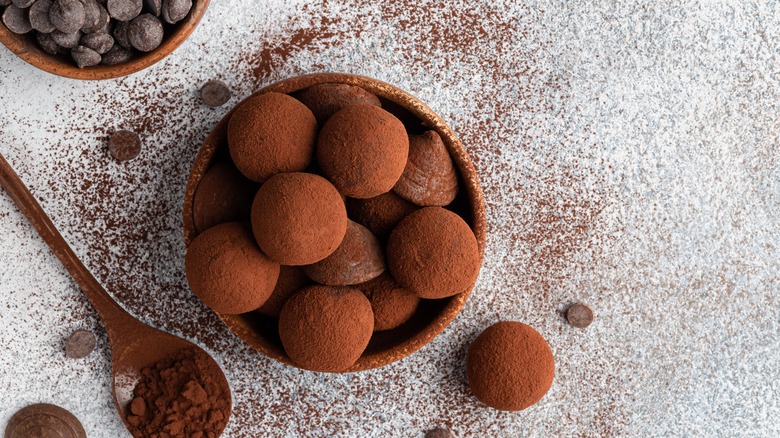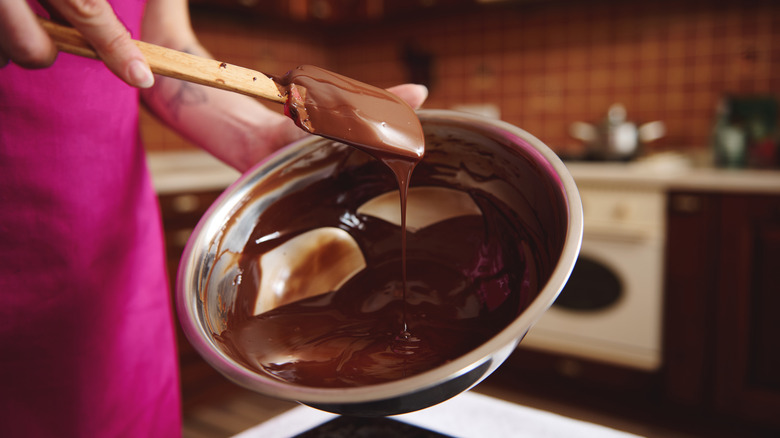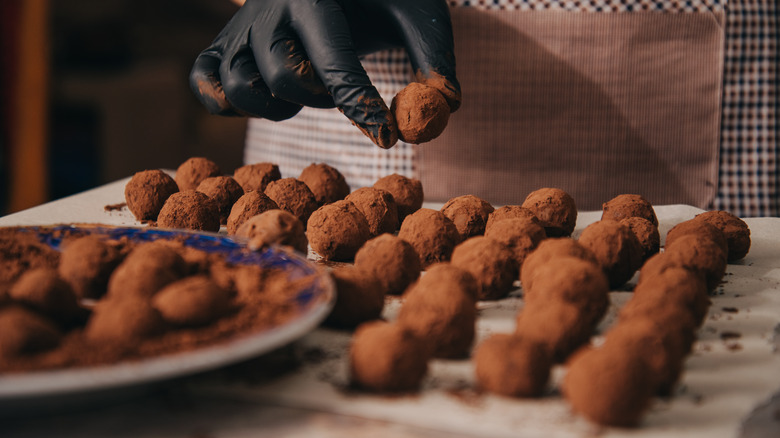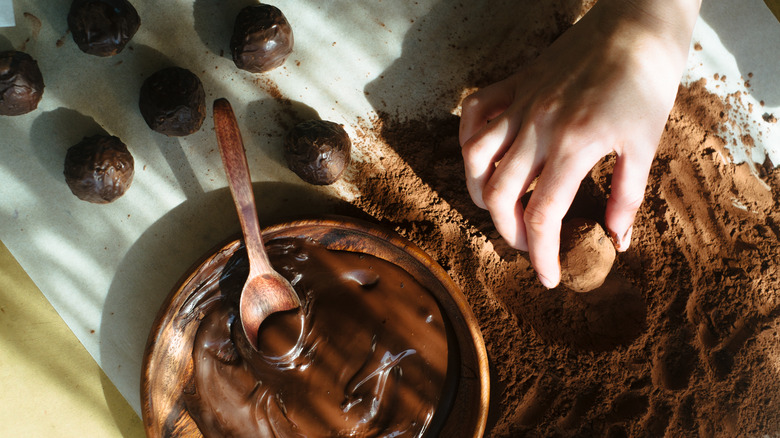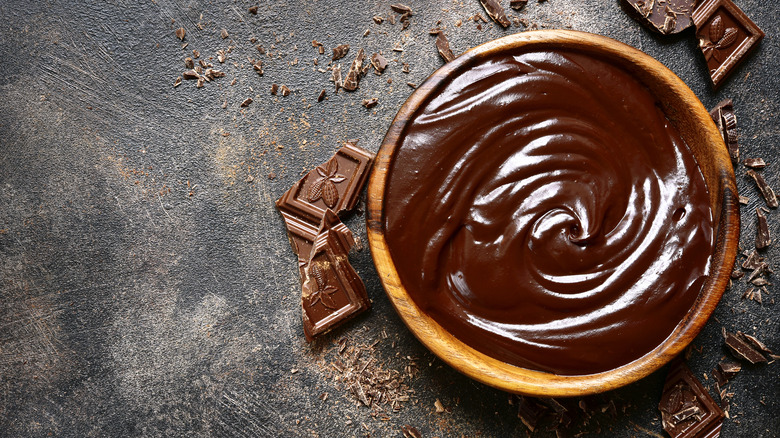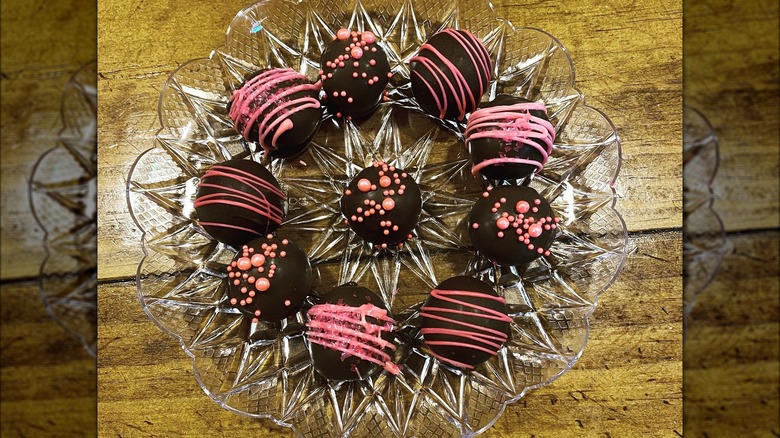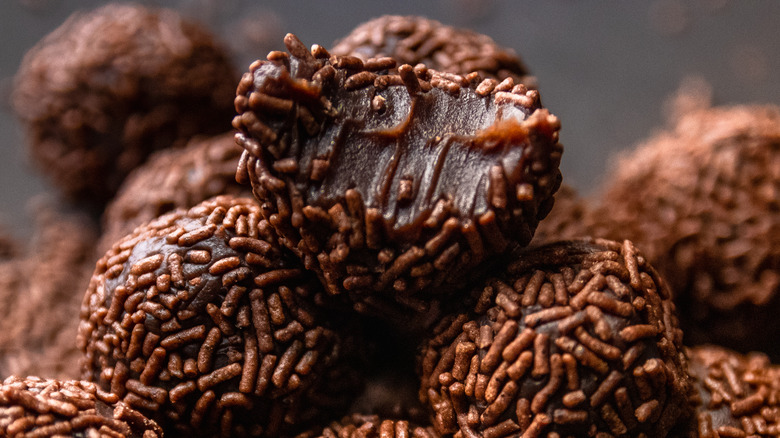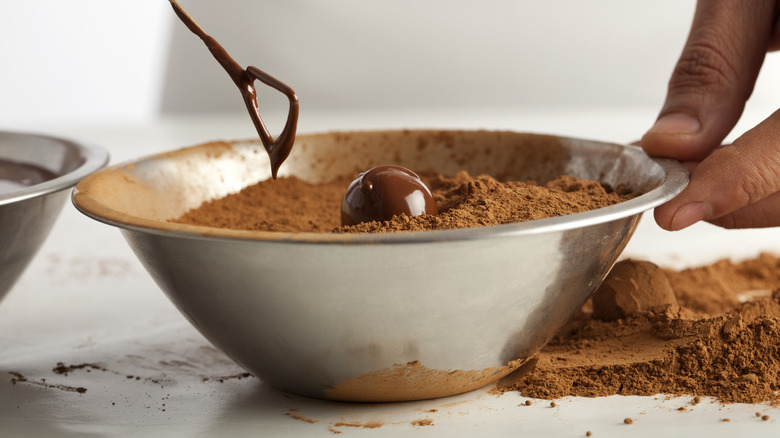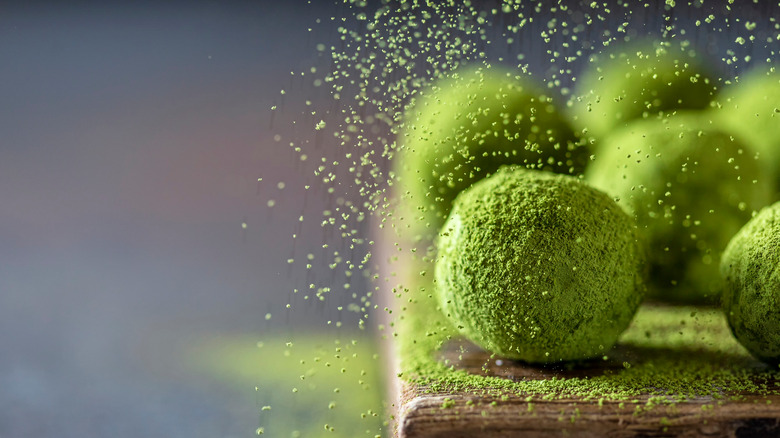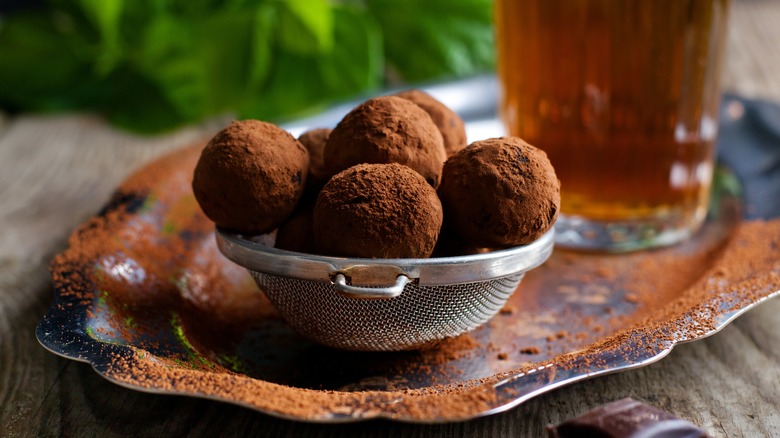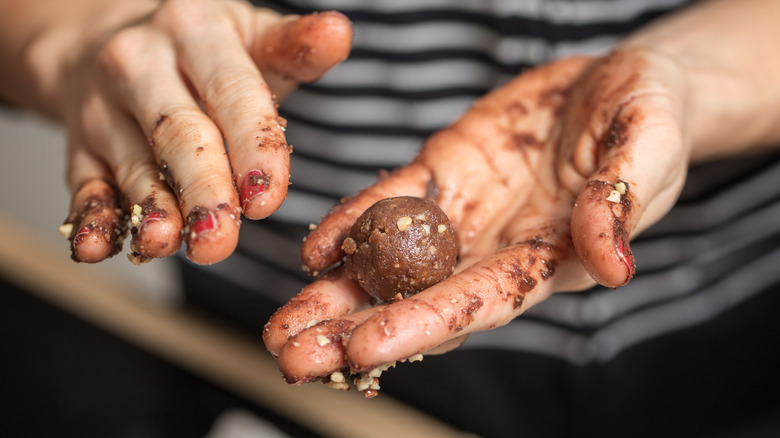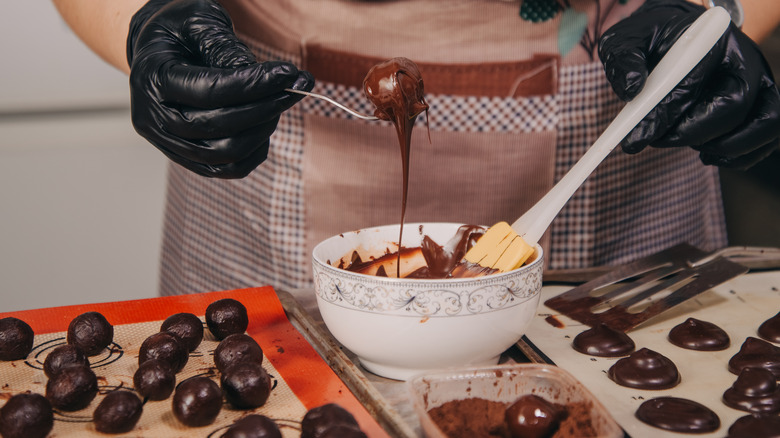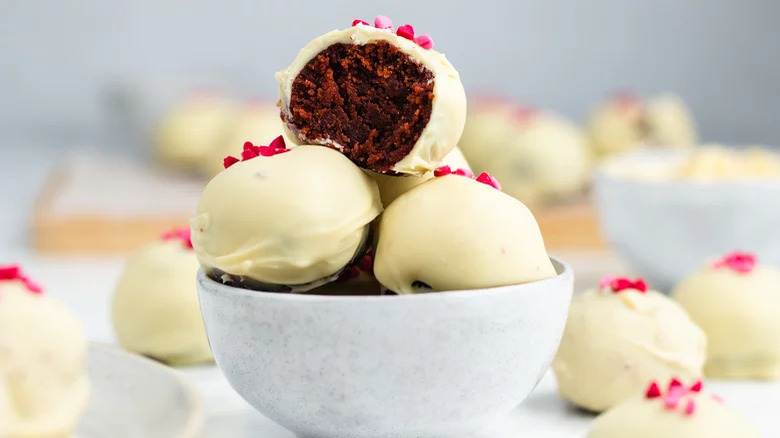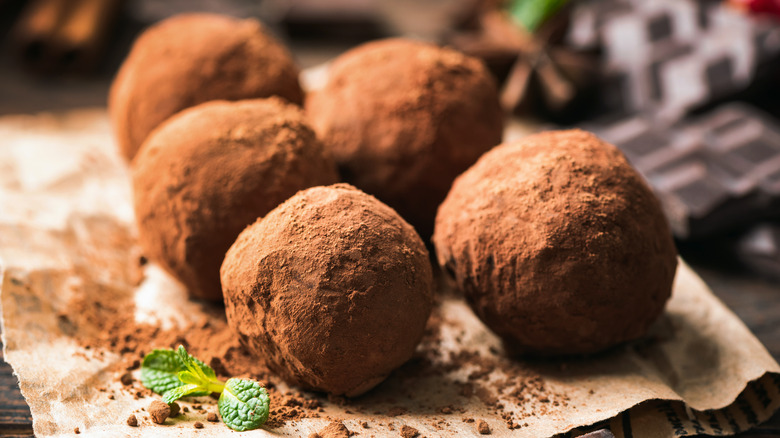13 Mistakes Everyone Makes With Chocolate Truffles
It's no controversy if we claim that chocolate truffles are luxurious and decadent, making them the ultimate treat for chocolate lovers. These dessert darlings have been seducing sweet tooths the world over since their beginnings in 19th-century France. One story goes that Auguste Escoffier himself mixed up his ingredients and combined hot cream and chocolate by accident, creating the chocolate truffle (via Charbonnel).
Master chocolatier Richard Tango-Lowy of Dancing Lion Chocolate loves making truffles and tells Mashed that the definition of this treat gets pretty specific. "A traditional truffle is a ganache center enrobed in a thin layer of tempered chocolate and dusted with cocoa powder. It's called a truffle because of its resemblance to the mushroom of the same name. A perfect truffle should hit you with a bit of tartness on the tongue from the cocoa powder. The paper-thin shell then gives way to a silky center that melts immediately, exploding with chocolate flavor."
If you're trying out truffle-making at home, you're going to want to get them just right, too. Here are some common mistakes everyone makes when it comes to crafting chocolate truffles and how to avoid or fix them.
Thinking you have to temper the chocolate
Tempering chocolate to just the right temperature and texture can get tricky, so it's no surprise that there are plenty of things that can go wrong along the way. One issue is moisture, which can cause chocolate to seize up into an unsightly mess. You also can't overheat the chocolate, lest a similar issue happens. And of course, you have to adjust your technique to the type of chocolate you're using.
However, not every truffle has to be tempered. Our white chocolate truffles recipe shows that this isn't the case, although you do have to melt the chocolate so it mixes well with some cream cheese.
Truffle Me! owner Diane Haase told us that home cooks don't need to be quite so worried about this step, as tempering is more about looks than taste. "Tempering chocolate will give your truffles a nice shiny look and the chocolate will be 'snappy.' It is not necessary to temper chocolate for it to taste amazing. It's all about the look of the chocolate. I temper my chocolate because I have a truffle business, but for making truffles for yourself and friends you don't need to temper it."
Letting the ganache get too firm
Truffle making is all about melting ingredients and then letting them set. You'll want your ganache to be solid enough for you to roll it into a ball, so many recipes will encourage you to chill it in the fridge for a couple of hours before shaping your truffles. You then typically leave the finished truffles to harden enough so you can pick one up and pop it in your mouth, and so feel all is right with the world.
But what if your ganache is too firm? No, you don't have to start again or add in other ingredients. Instead, follow a simple tip from recipe creator Catherine Brookes. If the ganache has become too hard to scoop, let alone roll, then warm it up in the microwave. You need to be careful here, as you don't want to ruin all that gorgeous ganache, so work in small increments of time. Stick it in the microwave for 10-20 second bursts. With a little care, the ganache should soften enough to get you back to scooping and rolling with ease.
Not using the right chocolate to cream ratio
There aren't a whole load of ingredients for most truffle recipes. Martha Stewart, for example, has a super simple truffle recipe that's made with just five ingredients. As well as heavy cream and semisweet chocolate, you only need kosher salt, unsweetened cocoa powder, and vanilla extract to make these treats. Because the main ingredients are cream and chocolate, it's important to get the ratio of these two ingredients as close to perfect as possible.
Tango-Lowy says that ganache can become too dense because it's not made correctly. It's not just about proportions, either, but how you mix the ingredients. "For truffles, the basic recipe is equal parts chocolate and cream by weight. Gently melt the chocolate, then stir in the cream in thirds, beating it vigorously between additions, until the result is shiny and silky."
One Reddit tipster suggests that if your measurements aren't right and the ganache won't set at room temperature, you can melt the ganache and add cream if it's too hard. If it's too soft, then you can try to melt the mix again and add some extra chocolate.
Not getting the cream to the correct temperature
When it comes to making delicious truffles, getting the cream hot enough to melt the chocolate is key. But when you pour the cream on top of the chocolate chips, you may find that not all of them melt. If this happens and you've already added the cream, then pop the mixture in the microwave. Give it a quick 20-30 second blast and this should see those lingering unmelted chips surrender to the heat. Make sure to stir the ganache afterward to ensure that everything has evenly melted. It's also important that you get your cream properly boiling before adding it to the chocolate, though you can take it off the heat when you're pouring it over the chips.
Tasting Table suggests that getting the cream too hot will also burn the chocolate. The solution? Once you've brought it to a simmer on the stove, give it a minute to slightly cool down before melting the chocolate with it. Try microwaving cream in small quantities so that you have more control over the process. If the mik isn't hot enough and you don't want to microwave the ganache, then try stirring the mix as it melts in a bowl over another one filled with hot water.
Missing creative opportunities
Everyone is surely familiar with the classic tempered chocolate truffle dusted in cocoa powder. They're a classic sweet treat, whether you make them for a special person as a gift or for lots of lucky diners for a special occasion. That doesn't mean you can't have fun and try out a few different varieties, like our romantic red velvet truffles made by mixing red velvet cake with frosting, then dipping the mixture in melted white chocolate chips. There are also our easy Oreo truffles made with cream cheese and crushed cookies, with white chocolate coating on the outside.
Haase is also a big fan of getting creative with truffle decorations, shaping, and even matching them to an event. "There are so many kinds of sprinkles and colored chocolate that your decorating ideas can be endless," she says. "Think about forming the truffle into a heart for Valentine's Day, 'melting' snowmen for winter, truffle 'pops' for birthdays, or customizing a color theme for a wedding or birthday." Once you step outside the traditional truffle mindset there's a whole culinary world of wonder you can explore.
Making grainy truffles
Chocolate isn't an easy ingredient to work with, says Tango-Lowy. "Chocolate is my passion. I will never master her – who can master one so willful and tempestuous? But I will continue to woo her and to craft a small bit of her soul into each truffle and bonbon I create." Since he used to be a physicist, he also knows that there's a fair bit of science that goes into the mix as well. This can help if your ganache is too crumbly or grainy.
Scientifically Sweet suggests that it's the cocoa butter in chocolate that's the culprit here, as it can crystallize in unique ways that affect its interaction with other ingredients. In fact, according to Imperial College London, chocolate can achieve six unique crystalline structures. To get that smooth texture, pay attention to the temperature and make sure that your chocolate pieces are a uniform size. If they're small, then you're more likely to melt them quickly and evenly. To get there, let the heated chocolate and cream sit together before stirring, allowing the two ingredients to work their magic. As the cream cools down, and the chocolate heats and melts, the temperatures of the two ingredients will meet in the middle. Then it's time to stir. And when you do, be more gentle with the mix rather than becoming a human concrete mixer. A vigorous mixing will add air and dull the shiny emulsion.
Allowing the chocolate shell to get too thick
Coating a truffle in chocolate isn't that easy, so it's no surprise that there are a few issues that can arise at this stage, not to mention a whole lot of mess. You've made your ganache and got that just right so it's not too hard and not too soft. Now you want to add that delicately thin chocolate coating to create the unmistakable sensation of biting through snapping crunch to the soft, velvety inside. But if your shell is too thick, then your truffle may end up looking downright clunky.
This is exactly what you don't want, as Tango-Lowy explains. "A truffle isn't a golf ball, it's a delicacy. It should deliver a lot of flavor in just one or two tiny bites," he says. "To enrobe, put a spoonful of tempered chocolate into your palm, then quickly roll the ganache center in it to coat. Drop the coated center in a bowl of cocoa powder and roll it around until completely covered." So long as you don't mind getting a bit of chocolate on yourself, the solution here is refreshingly simple.
Not playing around with different coatings
While there's something darn near perfect about a tempered chocolate shell on a truffle with a simple dusting of cocoa powder, there are more than a couple of ways to innovate the coating on this sweet treat. While it's not strictly a mistake to stick to a classic idea, it could be seen as an error not to experiment or at least try out different suggestions. This creativity can add a multitude of flavor combinations and textures to a truffle.
Closing off from this means you may miss out on making a truffle with garam masala and a bit of chili, for instance. There are plenty of amateur chocolate truffle makers offering a bevy of coating ideas on Reddit to make your truffles stand out.
Consider truffles coated with matcha or toasted coconut, for instance. Of course, you could leave the fancy coatings to the experts. Dancing Lion Chocolate makes an undoubtedly unique Turkish bay and Hungarian paprika truffle finished with coarse sugar, while the lavender hijiki caramel truffles are coated in dark chocolate and lavender sugar. Truffle Me! adds some spice, too, with cayenne pepper truffles that come with sprinkles or a red drizzle.
Not adding flavorings correctly
It's not just the outside of truffles that you can change up with decorations and coatings. There are quite a few ways to change up the interior, according to Homemade Gift Guru. If you want to add bits of toffee or a liqueur then put these ingredients into the ganache while it's still warm. The mix-ins should be room temperature or your ganache might start to react and change texture, and not in a good way.
You can also add flavor by infusing the cream with herbs and spices as you heat it. Just remember to strain the mixture so unwanted bits of herbs don't make it into your finished truffles. You can also add these ingredients to cold cream and let it steep for a day in the fridge. With this method, try stronger-flavored ingredients like coffee beans and citrus peel. But however you add flavor to truffles, be careful that you don't go overboard. It's far better to have a hint of a flavor than one that's so strong it dominates the final treat. Moreover, if you're using liquid flavorings, reduce the cream by the same amount so the consistency remains the same.
Making a mess when rolling the truffles
Haase has plenty of years of experience and tips for making the perfect truffle, with wisdom she says is earned from making "a lot of mistakes working with chocolate!" One common issue she and others have encountered in truffle making is the seemingly inevitable mess when it comes time to roll and coat the sweets. But is it all that inevitable?
Perhaps, as Haase has found, it's a neater process when the texture of the truffle base is just right. "I have found that if my dough is very soft and hard to roll, I add half a cup of powdered sugar," she says. "I also make sure the dough is very cold when I roll it. I have a few recipes that I roll and dip frozen in order for them to keep their shape."
Meanwhile, a Redditor suggests avoiding mess by making sure your hands are really dry before you start rolling. They also recommend adding some warmed cream to the mix if it doesn't seem hard enough. But perhaps the only way to not make a mess while rolling is to make a few mistakes, as we suspect that it's only by making a mess that you might learn how to avoid it in the first place.
Getting a rough finish
You don't need to be a culinary whizz or a scientific genius to know that, if you put something fairly soft into melted chocolate, it might start to melt itself. So, when you're making truffles and you get to the part where you dip balls of ganache into chocolate, the trick is to do it quickly. However, that's easier said than done when you're dipping something small and round. After all, you want your truffles to not only not melt, but look neat too.
Perhaps Reddit has the answer. Users suggest grabbing a fork to dip your truffle, then placing it on parchment paper to set. If the top is looking less than smooth, try remedying this with your fork. You can also use a toothpick and wait for excess chocolate to drip off before setting the truffle down. You can also try dipping and then letting your truffles cool a little before rolling them in your hands to smooth them.
You should probably accept there will be a little "foot" on the bottom of the coated truffle because even with the best dipping skills in the world, you're only going to get something like perfection with a round mold. Or you can reframe the "problem" and turn the lack of neatness into a design feature by creating swirling chocolate designs and using decorations to cover the surface.
Letting the mix get soggy
There are plenty of truffle-style recipes that use cake, creating a result that is similar to cake pops but without the stick. Although they're not technically truffles in that these treats don't employ ganache, they remain delicious. If you're crafting cake truffles, one mistake that's easy to make is allowing the cake mixture to become overly soggy. The quick fix in such a situation is to add in more cake, assuming you have some at the ready, according to Oasis Bakery York on TikTok.
Of course, a bit of self-awareness is key here, too. If you're adding in liquid or less-than-solid additions, like cream, frosting, or rum (as Oasis Bakery has done), then add a little at a time. As even a moderately experienced home chef can tell you, it's often far easier to add more of an ingredient than it is to take some away from a mix.
Not storing chocolate truffles correctly
You may find some seriously conflicting information when it comes to storing truffles properly. Cocoa & Heart suggests a cool, dry environment with a stable temperature. Too much humidity (like what food experiences in a fridge) can make your chocolate bloom, as evidenced by a filmy gray residue on the surface. Though it's unsightly, bloomed chocolate is safe to eat. Meanwhile, overly warm temperatures can melt your carefully crafted truffles and may also contribute to blooming.
When it comes to storage, Tango-Lowy stresses that time is of the essence when truffles are involved. "Unless you're a professional and have studied shelf life and formal production techniques, don't plan to keep your truffles for more than a few days," he says. "Mold can form between the ganache and shell." The silver lining here: if you make your own truffles, this is a great excuse to eat them all in a short space of time.
